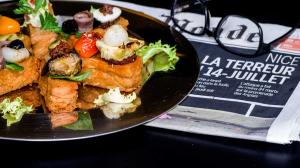STOP IT ! STOP IT ! STOP IT ! STOP IT ! STOP IT ! STOP IT ! STOP IT ! STOP IT ! STOP IT ! STOP IT ! STOP IT ! STOP IT ! STOP IT ! STOP IT ! STOP IT ! STOP IT ! STOP IT ! STOP IT ! STOP IT ! STOP IT ! STOP IT ! STOP IT ! STOP IT ! … sorry, but I needed to get that out of my system. Terrible and tragic and unforgiveable things have happened and my heart aches for the people of Nice and the victims and their friends and their families and everyone who cares. I haven’t allowed myself to shed a tear until finally making this and posting it … Support can be expressed in different ways.
My deepest & sincerest condolences.
NICE; what are the flavours & dishes of this city and its region : the famous salade niçoise (with fresh tomatoes, artichoke hearts, green onions, green peppers, basil leaves, olive oil, garlic, salt, pepper, anchovies and hard-boiled eggs), pissaladière (onions, olives, garlic, anchovies pizza), warm goat cheese on toasted bread with mesclun (baby salad greens), fougasse (flatbread), tarte de blettes (sweetened chard tart), ratatouille (stewed vegetable dish), daube (meat stew), black olives & olive oil, socca & panisse (savoury chickpea flour pancakes) …
Many of the city’s culinary influences are from the Liguria region in north-western ITALY which spread from Genoa to Nice (which officially became part of France in 1860) and westwards until Marseille. Nice claims the “socca” and Marseille often likes to claim the “panisse” but panisse is consumed from Genoa to Marseille (with Nice in the middle). In Liguria, the savoury chickpea flour recipe is called “farinata”. All 3 are made with chickpea flour, water, salt & olive oil. SOCCA is more liquid and thinner and is baked flatter & wider like a huge pancake or crêpe and PANISSE is a much thicker, more compact batter that is prepared by partly cooking in hot water, pouring in a mold, refrigerating, then cutting up in smaller pieces and frying or oven-baking.
Of course, some will disagree on the origin, but my versions are panisse sticks covered in the flavors of Nice. The way I see it, it’s called and pronounced pa-nisse, right ?!
SHARE THE FOOD LOVE … :)









